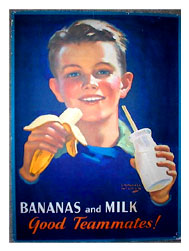Sosúa got its name from the Sosúa River which flows through this region. The river ends in Sosúa Bay about 1,400 feet from the west side of Sosúa beach. The word Sosúa means “worm” in the native language of the Chibchas, an indigenous culture that lived predominantly in the northern part of South America. The Chibchas, Arawak, and other tribes migrated through the Lesser Antilles, and eventually settled in Hispaniola, Puerto Rico, and Cuba.
At the beginning of the 20th Century, the United Fruit Company established a banana plantation in the sparsely populated land surrounding Sosúa. Bananas were a highly prized commodity in the United States, and so big plantations cropped up in several tropical countries. The United Fruit Company plantation had over 1.5 million banana trees, and in the year 1900 they exported 230,000 bunches to the United States alone. A private rail system to transport bananas from the plantations to Sosúa beach contributed to the development of the banana industry and to the colonization of the region. Many people moved to this region to work on the banana plantations and the region flourished. As many as 20 houses, several larger buildings, electricity and running water was available. The banana export initially grew, reaching 640,000 bunches in 1907. As many as 17 vessels per year came to Sosúa Bay to load bananas that arrived in Sosúa. These were then loaded onto barges at the port that transported the bananas to the carrier vessels. Remains of the port are still seen at the east side of Sosúa beach, named by the settlers’ children Los Pilotillos. However, several years of bad weather and inappropriate soil and water conditions caused exports to decline to 400,000 bunches in 1911. United Fruit later closed the Sosúa banana operations in 1916.
About 20 houses and several barracks were left by United Fruit Company. In the mid-1920s several wealthy families from Santiago spent their summer vacation in Sosúa, where they stayed in the houses and barracks. The land was hardly ever used again for plantations or agriculture. In 1938, Rafael Leonidas Trujillo, the Dominican dictator, bought the entire property.


4 Responses to Sosúa before 1939